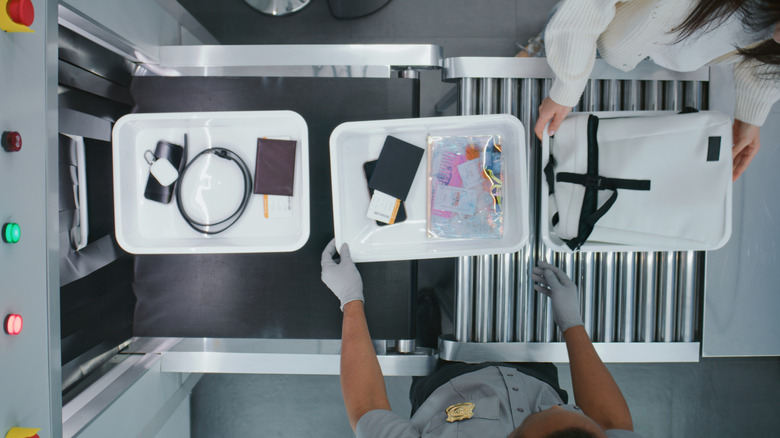Here's What Bag Scanners At Airport Security Really Show
It seems like everything at airport security is designed to be a hassle. At terminals around the world, passengers are frequently required to take off their shoes and belts, remove their jewelry, put every container of liquid in a separate plastic bag, dump out water bottles, and take out their laptops while trying to catch a flight. Most people likely leave security lines irritated and exhausted. And you might be wondering why this is all necessary with the presence of advanced scanning machines. Well, it's important to break down what a bag scanner does and what it really shows the TSA agent operating it.
You're probably somewhat familiar with how these machines work, as it's the same technology you'd find at the hospital if you've ever gotten an X-ray. As your bag glides through the scanner, it is hit with low doses of electromagnetic radiation. These beams travel through various materials differently — like organic content, liquids, and solids — allowing the machine to generate a 2D image showing the density and shape of the objects based on the material's absorption of the radiation. Many airports have upgraded to Computed Tomography X-rays, or CT machines, to get a more accurate, 3D image of the things in your bag.
The primary purpose of a bag scanner (and all other security measures for that matter) is to keep us all safe at the airport and on the plane. And as annoying as the process can be, agents are usually just looking for things banned from flights, which obviously includes dangerous items like explosives. So, unfortunately, you'll need to leave your fireworks and bear spray at home and your katana sheathed and tucked into your checked bag, unless you want to be pulled aside by the TSA for an additional screening.
How airport security technology works
You'll be happy to know that things are slowly changing in the commercial aviation world. The technology used for scanning has improved significantly in recent years. Smiths Detection machines use dual energy CT technology to better identify the type of solid material or liquid in your bag by analyzing how the X-ray beams are absorbed at different levels. Each element absorbs the rays based on its atomic number and density, giving the scanner a clearer picture of an item's material makeup in a passenger's bag. And this also helps agents spot items containing elements like lithium, which, as most frequent flyers know, is not allowed in checked luggage (this common item could even eventually be outright banned, according to Reddit).
Additionally, in the newest Smiths Detection machines, the X-ray emitter actually rotates around the object as it passes through, combining the 3D imaging with the 2D X-ray technology. This allows for a clearer image that can be moved and rotated on-screen by the agents. And the next generation of machines may make airport security significantly smoother. Using methods like scattering and diffraction of X-rays, these future machines will be even more accurately able to identify the molecules of the materials in your bags.
With so many new developments in scanning technology, you're probably confused about why you're still asked to remove every electronic device and bottle of liquid from your bag. Well, these dense items can conceal other objects in your bag. Plus, not every airport utilizes the latest tech, and older scanners might not clearly show agents what the item is. So, for the time being, you still need to comply with agents' requests and go through the rigmarole of emptying your bag.

